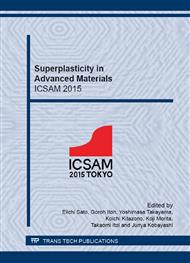[1]
A.A. Salem, T.G. Langdon, T.R. McNelley, S.R. Kalidindi, S.L. Semiatin, Strain-path effects on the evolution of microstructure and texture during the severe-plastic deformation of aluminum, Metall. Mater. Trans. A 37 (2006) 2879-2891.
DOI: 10.1007/bf02586120
Google Scholar
[2]
Y. Iwahashi, Z. Horita, M. Nemoto, T.G. Langdon, The process of grain refinement in equal-channel angular pressing, Acta Mater. 46 (1998) 3317-3331.
DOI: 10.1016/s1359-6454(97)00494-1
Google Scholar
[3]
M. Kawasaki, Z. Horita, T.G. Langdon, Microstructural evolution in high purity aluminum processed by ECAP, Mat. Sci. Eng. A 524 (2009) 143-150.
DOI: 10.1016/j.msea.2009.06.032
Google Scholar
[4]
A. Yamashita, D. Yamaguchi, Z. Horita, T.G. Langdon, Influence of pressing temperature on microstructural development in equal-channel angular pressing, Mat. Sci. Eng. A 287 (2000) 100-106.
DOI: 10.1016/s0921-5093(00)00836-4
Google Scholar
[5]
K. Edalati, Z. Horita, High-pressure torsion of pure metals: Influence of atomic bond parameters and stacking fault energy on grain size and correlation with hardness, Acta Mater. 59 (2011) 6831-6836.
DOI: 10.1016/j.actamat.2011.07.046
Google Scholar
[6]
T. Morishige, T. Hirata, T. Uesugi, Y. Takigawa, M. Tsujikawa, K. Higashi, Effect of Mg content on the minimum grain size of Al-Mg alloys obtained by friction stir processing, Scripta Mater. 64 (2011) 355-358.
DOI: 10.1016/j.scriptamat.2010.10.033
Google Scholar
[7]
T. Morishige, T. Hirata, M. Tsujikawa, K. Higashi, Comprehensive analysis of minimum grain size in pure aluminum using friction stir processing, Mater. Lett. 64 (2010) 1905-(1908).
DOI: 10.1016/j.matlet.2010.06.003
Google Scholar
[8]
S. Kobayashi, T. Kawakatsu, Y. Takigawa, T. Uesugi, K. Higashi, Relationship between strength and grain size of friction stir processed and annealed high purity aluminum, Adv. Mater. Res. 922 (2014) 372-375.
DOI: 10.4028/www.scientific.net/amr.922.372
Google Scholar
[9]
F.A. Mohamed, A dislocation model for the minimum grain size obtainable by milling, Acta Mater. 51 (2003) 4107-4119.
DOI: 10.1016/s1359-6454(03)00230-1
Google Scholar
[10]
S. Lu, Q.M. Hu, E.K. Delczeg-Czirjak, B. Johansson, L. Vitos, Determining the minimum grain size in severe plastic deformation process via first-principles calculations, Acta Mater. 60 (2012) 4506-4513.
DOI: 10.1016/j.actamat.2012.04.024
Google Scholar
[11]
T. Tanaka, Impurities in commercial pure aluminum, J. Japan Inst. Light Metals 36 (1986) 253-254.
DOI: 10.2464/jilm.36.253
Google Scholar
[12]
K. Tanaka, K. Ito, H. Yamagata, M. Otsuka, Dynamic recrystallization of 99. 999 mass% aluminum polycrystal, J. Japan Inst. Metals 63 (1999) 859-865.
DOI: 10.2320/jinstmet1952.63.7_859
Google Scholar
[13]
M.E. Kassner, J. Pollard, E. Evangelista, E. Cerri, Restoration mechanisms in large-strain deformation of high purity aluminum at ambient temperature and the determination of the existence of steady-state, Acta Metall. Mater. 42 (1994) 3223-3230.
DOI: 10.1016/0956-7151(94)90420-0
Google Scholar
[14]
T. Inoue, Z. Horita, H. Somekawa, K. Ogawa, Effect of initial grain sizes on hardness variation and strain distribution of pure aluminum severely deformed by compression tests, Acta Mater. 56 (2008) 6291-6303.
DOI: 10.1016/j.actamat.2008.08.042
Google Scholar
[15]
J. Ibáñez, J. Castellano, G. González-Doncel, In-situ SEM observation of microstructural evolution of high purity aluminum deformed at elevated temperatures, Materials Transactions, JIM 37 (1996) 63-66.
DOI: 10.2320/matertrans1989.37.63
Google Scholar
[16]
I. Poschmann, H.J. McQueen, Work hardening behaviour and subgrain size distribution of hot worked aluminium, Mater. Sci. Technol. 14 (1998) 1101-1108.
DOI: 10.1179/mst.1998.14.11.1101
Google Scholar
[17]
K. Masaki, Y.S. Sato, M. Maeda, H. Kokawa, Experimental simulation of recrystallized microstructure in friction stir welded Al alloy using a plane-strain compression test, Scripta Mater. 58 (2008) 355-360.
DOI: 10.1016/j.scriptamat.2007.09.056
Google Scholar
[18]
H.J. McQueen, J.E. Hockett, Microstructures of aluminum compressed at various rates and temperatures, Metall. Trans. 1 (1970) 2997-3004.
DOI: 10.1007/bf03038412
Google Scholar
[19]
T.S. Lundy, J.F. Murdock, Diffusion of Al26 and Mn54 in Aluminum, J. Appl. Phys. 33 (1962) 1671-1673.
DOI: 10.1063/1.1728808
Google Scholar
[20]
C.I. Chang, C.J. Lee, J.C. Huang, Relationship between grain size and Zener-Holloman parameter during friction stir processing in AZ31 Mg alloys, Scripta Mater. 51 (2004) 509-514.
DOI: 10.1016/j.scriptamat.2004.05.043
Google Scholar
[21]
O.D. Sherby, A. Goldberg, O.A. Ruano, Solute-diffusion-controlled dislocation creep in pure aluminium containing 0. 026 at. % Fe, Philos. Mag. 84 (2004) 2417-2434.
DOI: 10.1080/14786430410001690006
Google Scholar
[22]
K. Takeshima, T. Uesugi, Y. Takigawa, K. Higashi, Dislocation creep in al-22. 2, 53. 6 and 101 at. ppm Fe solid solution alloys, Adv. Mater. Res. 922 (2014) 749-754.
DOI: 10.4028/www.scientific.net/amr.922.749
Google Scholar
[23]
T. Uesugi, K. Higashi, First-principles studies on lattice constants and local lattice distortions in solid solution aluminum alloys, Comput. Mater. Sci. 67 (2013) 1-10.
DOI: 10.1016/j.commatsci.2012.08.037
Google Scholar
[24]
A.H. Cottrell, Effect of Solute Atoms on the Behaviour of Dislocations, Report of a Conference on Strength of Solids, Phys. Soc., London, 1948, pp.30-38.
Google Scholar


